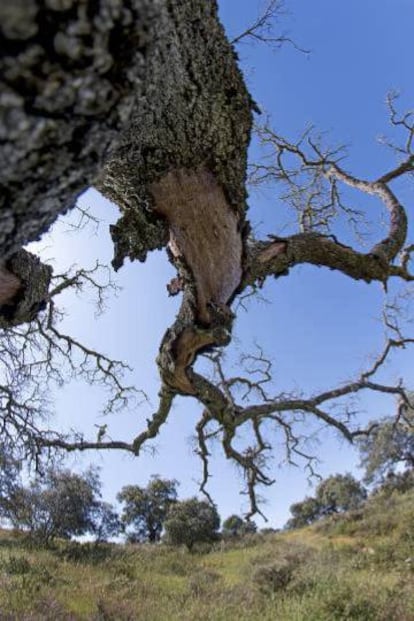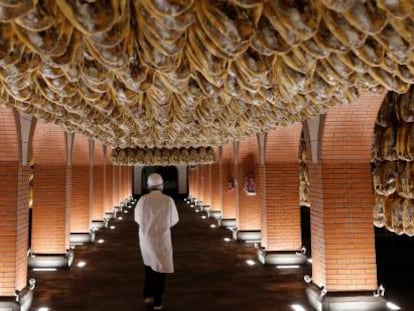Could a fungus wreak havoc in Spain’s Iberian ham industry?
A pathogen is attacking holm oak trees, drying out the ‘dehesas’ and leaving native pigs without their diet of acorns

The dehesa is sick | This article includes a 360º video which is best viewed on a cellphone. Click on the image above to launch it. While it is playing, move your phone around or click on the image and drag to see what is happening around you. You can also view it using a VR headset. If it does not load properly on your device, click on this link.
“Oh...ooo, oh….ooo, oh...ooo,” is the curious sound Antonio Ponce Limón makes to attract a group of Iberian pigs. As the farmer from Andévelo de Huelva walks across the dehesa – an ecosystem created from the interaction between man and the Mediterranean forest – he explains why the sound works. “The animals recognize it and come,” he says. “They are very easy to scare but deep down are very curious.” Ponce spends a while looking for the pigs, who wander the property at will, searching out acorns. This nut is the principal diet for the Iberian, black and long-footed pig, the latter of which is local to the south-eastern peninsula and the origin of gastronomical treats such as acorn-fed Iberian ham.
Eradication of this disease is almost impossible
Researcher Raúl Tapias
The countryside that surrounds the animals is picturesque but the tranquil environment does nothing to allay Ponce Limón’s concerns: “Aggressive seca outbreaks began four or five years ago,” he explains. This is the name given in Spanish to Phytophthora cinnamomi, a pseudofungi that attacks the roots of trees. In a few months, sometimes in a matter of days, this pseudofungi is able to completely dry out a 100-year-old tree, and while it affects all tree species, it is particularly destructive against the holm oak (from the Quercus genus).
“This is the sweet holm oak,” says the farmer, pointing to a tree whose name comes from the sweetness of its fruits. Pigs love its acorns and it is also the emblem of the farm. Ponce Limón’s great-grandfather planted it in 1850. Three years ago, its branches began to show the first signs of seca. “The idea of losing it was painful to us, so we tried all measures to cure it,” says the farmer. After three years and multiple treatments, they succeeded. “We have spent €1,000 a year on just one hectare, an amount that we would not be able to invest in the entire affected area.” But this happy ending is not common. They have had to cut down 400 holm oaks at their farm: “We have lost up to 30% of our trees,” says Ponce Limón, “and this causing a very serious economic problem.”
A holm oak takes 40 years to produce its first acorn – this fungus can destroy it in days
The phytophthora was first identified in Andévalo de Huelva in Andalusia in 1986. Little by little, it spread into new territory. In the past decade, almost half-a-million oak trees have been lost to the pseudofungi. It’s also a problem in Extremadura, where the number of areas affected has jumped from 450 in 2000 to nearly 10,000 this year.
“We’ve been speaking about this pathogen for decades, but nothing serious has been done up to now,” says a worker within the Andalusian regional government, who preferred to remain anonymous. “The dehesa is straddled between agriculture and the environment, meaning there has been no coordination between administrations. Now, when the problem is already serious, the Andalusian regional government has just announced an investment of €32 million until 2020 to ensure the dehesa’s future.”

According to calculations from the Agriculture Ministry, there are around 3.5 million hectares of dehesa in Spain, principally in the regions of Extremadura and Andalusia. This is not a natural ecosystem. It was made by man during the Middle Ages as a breeding ground for cattle and has remained for centuries thanks to a complex and delicate balance. The phytophthora – a name of Greek origin that means “plant destroyer” – is upsetting this balance.
This pathogen was first identified in Europe in 1876. Since then, it has spread throughout the world: the International Union for Conservation of Nature (IUCN) considers it one of the most harmful invasive species on the planet. Not only is the microscopic pseudofungi spreading, its attacks are becoming more aggressive.
“The outbreaks have been aggravated by climate change,” explains Raúl Tapias, an agroforestry specialist who has spent decades investigating the problem at the University of Huelva. “This pathogen becomes more virulent in situations where the soil temperature is higher. Given future climate-change scenarios predict an increase in temperature, the area affected by the phytophthora will also have to grow,” he adds. “What’s more, it can stay for longer periods in the soil so eradication is almost impossible.”
We have lost up to 30% of our trees
Farmer Ponce Limón
Biologist María Castro collaborated with Tapias on his research and also works for the ham company Cinco Jotas: “We export our hams to 37 countries. It is a product that is known internationally and highly valued. The dehesa is key to the business. We depend completely on the acorns,” she explains. Iberian pigs solely eat the fruit of trees from the Quercus genus (holm oaks, gall oak and cork oak). “Without holm oak or cork oak trees there will be no dehesa, no acorns, no ham like ours,” adds the biologist.
The threat of the phytophthora has pushed authorities, farmers, businesses and researchers to unite forces. Up until not long ago, they were trying to get rid of the disease but now they have accepted that they have to learn how to live with it. “We are trying to isolate the genetic code of trees which can hold out against the disease,” explains Tapias, who wrote his doctoral thesis on the subject. The goal is to plant oak trees that are resistant to the pathogen and will be able to repopulate the dehesa. The idea should work but time is running out. A holm oak takes 40 years to produce its first acorn. Meanwhile, the temperature continues to rise and the effects of the phytophthora continue to spread.
English version by Melissa Kitson.
Tu suscripción se está usando en otro dispositivo
¿Quieres añadir otro usuario a tu suscripción?
Si continúas leyendo en este dispositivo, no se podrá leer en el otro.
FlechaTu suscripción se está usando en otro dispositivo y solo puedes acceder a EL PAÍS desde un dispositivo a la vez.
Si quieres compartir tu cuenta, cambia tu suscripción a la modalidad Premium, así podrás añadir otro usuario. Cada uno accederá con su propia cuenta de email, lo que os permitirá personalizar vuestra experiencia en EL PAÍS.
¿Tienes una suscripción de empresa? Accede aquí para contratar más cuentas.
En el caso de no saber quién está usando tu cuenta, te recomendamos cambiar tu contraseña aquí.
Si decides continuar compartiendo tu cuenta, este mensaje se mostrará en tu dispositivo y en el de la otra persona que está usando tu cuenta de forma indefinida, afectando a tu experiencia de lectura. Puedes consultar aquí los términos y condiciones de la suscripción digital.
More information
Archived In
Últimas noticias
Tiger Woods turns 50: Will he continue playing on the PGA Tour or take a back seat?
The surreal journey of James Nnaji, the Barcelona youth player selected in the NBA Draft who ended up in the NCAA
Trump claims peace in Ukraine is near, but Moscow suggests otherwise
A survivor’s account of the Interoceanic Train accident: ‘We were scared because of the speed on the curve’
Most viewed
- Oona Chaplin: ‘I told James Cameron that I was living in a treehouse and starting a permaculture project with a friend’
- Reinhard Genzel, Nobel laureate in physics: ‘One-minute videos will never give you the truth’
- Why the price of coffee has skyrocketed: from Brazilian plantations to specialty coffee houses
- Pablo Escobar’s hippos: A serious environmental problem, 40 years on
- Chevy Chase, the beloved comedian who was a monster off camera: ‘Not everyone hated him, just the people who’ve worked with him’











































